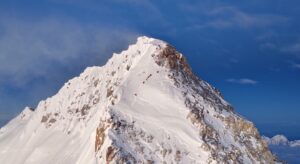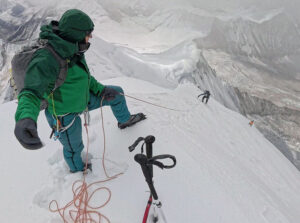A last-minute rule change may throw the Everest season into turmoil. To avoid overcrowding, teams must go in the order of their permit number.
As the prospect of vast lines of climbers getting stuck again in a traffic jam near the summit of Mount Everest becomes more likely, Nepal has issued another peculiar regulation to circumvent that embarrassment.
Outfitters have been told “that first permitted groups will get the first chance at summit push,” Everest Today‘s blogger Chabbi Pokhrel confirmed to ExplorersWeb. “It states that permit numbers 6 to 38 will have to summit in an earlier weather window, followed by permit numbers 40 to 68.” The remaining climbers will have to wait for a third weather window.

For those who can read Nepalese, the notice issued today by Nepal’s Department of Tourism. Photo: Everest Today
The document, issued by Nepal’s Department of Tourism, was in Nepalese only. According to Pokhrel, it says that if the new regulation creates difficulty among climbing teams, it is the responsibility of the expedition agencies to coordinate the summit pushes and maybe agree to exchange turns. Whatever they do, he adds, “the number of climbers in one push should not be greater than 150 to 170.”
Everest permits at record levels
Permits for Everest in 2021 have already approached the record 2019 levels that created a global outcry after photos of vast crowds of climbers near the Hillary Step went viral. Some of those climbers had to wait so long for their turn on the summit that they perished when they ran out of oxygen, or from exposure or exhaustion from the already long summit push.
Already, officials have issued 377 duly paid permits for Everest, distributed over 40 teams. Yet neither the operators nor their clients had the slightest idea that they might face such limitations, even though because of general COVID uncertainty, most climbers waited until the last moment before signing up.
The measure most affects the teams that obtained their permits last. Three or more summit windows are hardly guaranteed. Even those with an early permit may for some reason not be ready to try when their turn comes. For example, those hoping to climb Everest without supplementary oxygen need longer acclimatization. Then there are those who are either planning a double-header or an “express” Everest climb (offered by some operators, such as Lukas Furtenbach). They have little time to wait their turn.
Problems with Everest rule change
The document also doesn’t specify exactly what authorities mean by “a summit window”. Is it the 24 hours of the summit day? The four or five days needed for the complete climb from Base Camp to the top and back?
How about traffic jams on lower sections, such as the Icefall and the Lhotse Wall? Will the measure apply to those coming from Lhotse and stopping only in Camp 3? Do they mean individual or team permits?
Finally, how are they going to enforce such a decision and stop those who have paid big bucks, including an $11,000 climbing fee? There are no policemen to regulate traffic on the route, and liaison officers are notoriously unreliable.
The first possible answer to all these questions is that everyone will simply ignore the new regulation, as they have previous restrictions on helicopter flights and posting pictures on social media. Disturbing photos of crowds last week on Annapurna have already created a stir in the mountaineering community, and Everest will have six times as many climbers on the mountain.
If the regulations are somehow enforced, everyone will simply have to hope for particularly favorable weather, good conditions on the mountain, and some climbers dropping out and lessening numbers without the need for intervention.

Freeway to the summit: The Bahraini Sheikh’s team has the first two permits for Everest this year. Photo: Bahrain Everest Instagram
So which team has the inside track on this staggered start? Coincidentally or not, it’s His Royal Highness, the Sheikh of Bahrain, and his large Royal Guard team, led by many of Seven Summit Treks’ most experienced Sherpa guides.
The Bahraini team still has time until all the fixed ropes are in place, but they had better shape up in a hurry: According to their Instagram posts, the expedition members have not yet gone through the Khumbu Icefall. Instead, they have spent days practicing their basic skills on the lower seracs.






